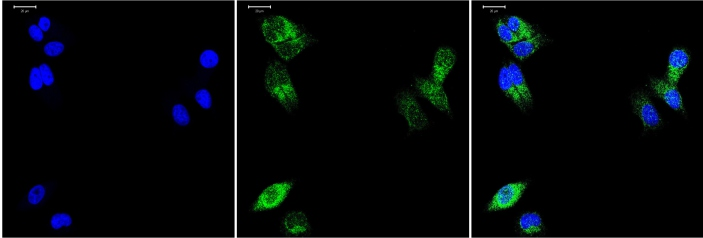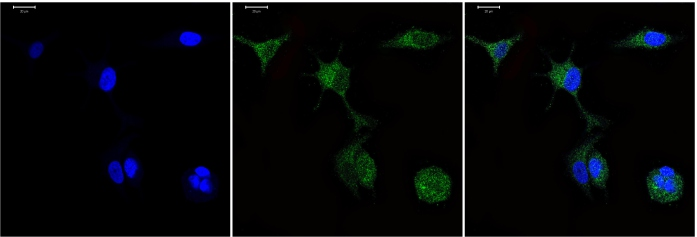Product introduction:
BersinbioTM has established a FISH Probe preparation platform to undertake customized fluorescence in situ hybridization kit business, which can be customized according to customer needs.
This kit is mainly used to detect the expression level and expression position of the target gene in the sample, and can be used for the detection of tissue sections (paraffin sections/frozen sections), Round coverslip and chromosome section.(This kit is for scientific research purposes only)
BersinbioTM FISH Kit series has been welcomed and affirmed by the majority of scientific research users since its listing, and has provided high-quality services to nearly a thousand users including domestic first-class scientific research institutes, medical institutions and multinational biological enterprises. For example, Chinese Academy of Sciences, Sun Yat-sen University School of Medicine and Affiliated Hospital, Southern Medical University School of Medicine and Affiliated Hospital, University of Hong Kong, Peking University School of Medicine and Affiliated Hospital, Southeast University School of Medicine, Jiangxi Agricultural University, Tongji Medical College of Huazhong University of Science and Technology, etc.
BersinbioTM uses the self-obtained specific probes from the research species and chemically covalently connects them with fluorescein. Autofluorescence probes have obvious advantages: high sensitivity, good light stability, and long fluorescence lifetime; the biggest advantage is that autofluorescence probes can effectively reduce self-specific fluorescence interference and achieve more efficient and specific gene detection signals. The comparison will produce great technical effects, gain customer approval and replace traditional probe detection, and meet the experimental needs of domestic and foreign scientific researchers for high-quality FISH Kits.
The research and development of the kit has received strong financial and policy support from the National Science and Technology Enterprise Innovation Fund and the Guangdong Province and Guangzhou Municipal Science and Technology Bureaus at all levels. The core technology of this product has applied for a national patent, which will protect the core technology and related supporting indicators. At the same time, after years of accumulation, a molecular probe research and development center was established in 2011. BersinbioTM has a strong fluorescence in situ hybridization technology team to provide technical support and answers to various problems encountered by customers in the use of the kit.

Principle of the experiment:
FISH is to hybridize the fluorescein-labeled oligonucleotide probe with the nucleic acid in the denatured chromosome, cell or tissue according to the principle of base complementary pairing. After denaturation, annealing, renaturation, and washing, a hybrid of target RNA and nucleic acid probe is formed. Finally, it is developed under a fluorescence microscope to perform qualitative and localization analysis of the RNA to be tested.
Technical process:
Result example:

mRNA FISH

LncRNA FISH

CircRNA FISH
Product features:
1、Safe, fast, and reproducible.
2、The specificity is 100% and the sensitivity exceeds 90%.
3、The probe is a direct labeling method, eliminating the need for a signal amplification system.
4、The probe has stable performance and can be stored at low temperature for more than one year.
5、The fluorescence signal is clear, and the result judgment is intuitive and reliable.
6、Simple operation, precise positioning, no experimental pollution.
7、Customize personalized probes according to customer needs.
Instructions
Bes1001 RNA-FISH(short chain)
Bes1002 RNA-FISH(long chain)
Bes1011 DNA-FISH
Articles
【In 2025】
Article:Lung metastasis and recurrence is mitigated by CAR macrophages, in-situ-generated from mRNA delivered by small extracellular vesicles.(DNA-FISH)
Periodicals:Nature Communications
IF:15.700
Article:Streamlined metal-based hydrogel facilitates stem cell differentiation, extracellular matrix homeostasis and cartilage repair in male rats.
Periodicals:Nature Communications
IF:15.700
Article: Statin therapy associated Lactobacillus intestinalis attenuates pancreatic fibrosis through remodeling intestinal homeostasis. NPJ Biofilms Microbiomes.
Periodicals:NPJ Biofilms and Microbiomes
IF:7.800
Article:TEC-mediated tRF-31R9J regulates histone lactylation and acetylation by HDAC1 to suppress hepatocyte ferroptosis and improve non-alcoholic steatohepatitis.
Periodicals:Clinical Epigenetics
IF:4.800
Article:Qufeng epimedium decoction alleviates rheumatoid arthritis through CYLD-antagonized NF-kB activation by deubiquitinating Sirt1.
Periodicals:Immunobiology
IF:2.500
【In 2024】
Article:LncRNA-Mediated TPI1 and PKM2 Promote Self-Renewal and Chemoresistance in GBM.
Periodicals:Advanced science (Weinheim, Baden-Wurttemberg, Germany)
IF:14.300
Article:EIF4A3 modulated circ_000999 promotes epithelial-mesenchymal transition in cadmium-induced malignant transformation through the miR-205-5p/ZEB1 axis.
Periodicals:Environment International
IF:10.300
Article:Periodic changes of cyclin D1 mRNA stability are regulated by PC4 modifications in the cell cycle.
Periodicals:The Journal of Cell Biology
IF:7.400
Article:MiR-4769-3p suppresses adipogenesis in systemic sclerosis by negatively regulating the USP18/VDAC2 pathway.
Periodicals:iScience
IF:7.100
Article:circ-1584 selectively promotes the antitumor activity of the oncolytic virus M1 on pancreatic cancer.
Periodicals:Molecular Therapy. Oncology
IF:5.299
Article:Hsa_circRNA_000166 accelerates breast cancer progression via the regulation of the miR-326/ELK1 and miR-330-5p/ELK1 axes.
Periodicals:Annals of Medicine
IF:4.900
Article:Sws2 Gene Positively Regulates Melanin Production in Plectropomus leopardus Skin via Direct Regulation of the Synthesis of Retinoic Acid.
Periodicals:International Journal of Molecular Sciences
IF:4.900
Article: MiR-4769-3p suppresses adipogenesis in systemic sclerosis by negatively regulating the USP18/VDAC2 pathway.
Periodicals:iScience
IF:4.600
Article:The IGF2BP2-lncRNA TRPC7-AS1 axis promotes hepatocellular carcinoma cell proliferation and invasion.
Periodicals:Cellular Signalling
IF:4.400
Article: LncRNA HOTTIP promotes LPS-induced lung epithelial cell injury by recruiting DNMT1 to epigenetically regulate SP-C.
Periodicals:Journal of cell communication and signaling
IF:4.100
Article:Long non‑coding RNA DANCR aggravates breast cancer through the miR‑34c/E2F1 feedback loop.
Periodicals:Molecular medicine reports
IF:3.400
Article:lncRNA H19 facilitates vascular neointima formation by targeting miR-125a-3p/FLT1 axis.
Periodicals:Acta biochimica et biophysica Sinica
IF:3.300
Article:LncIRF1 promotes chicken resistance to ALV-J infection.
Periodicals:3 Biotech
IF:2.600
【In 2023】
Article:circEIF3I facilitates the recruitment of SMAD3 to early endosomes to promote TGF-β signalling pathway-mediated activation of MMPs in pancreatic cancer
Periodicals:Molecular Cancer
IF:37.299
Article:CircFOXK2 promotes hepatocellular carcinoma progression and leads to a poor clinical prognosis via regulating the Warburg efect
Periodicals:Journal of Experimental &Clinical Cancer Research
IF:12.658
Article:MicroRNA miR-1275 coordinately regulates AEA/LPA signals via targeting FAAH in lipid metabolism reprogramming of gastric cancer
Periodicals:Cell Death and Disease
IF:9.697
Article:Marsdenia tenacissima extract prevents the malignant progression of glioma through upregulating lncRNA MEG3 and SFRP1-dependent inhibition of Wnt/β-catenin pathway
Periodicals:CNS Neuroscience & Therapeutics
IF:5.500
Article:Circular RNA hsa_circ_0005218 promotes the early recurrence of hepatocellular carcinoma by targeting the miR-31-5p/CDK1 pathway
Periodicals:Heliyon
IF:3.776
Article:SLERT, as a novel biomarker, orchestrates endometrial cancer metastasis via regulation of BDNF/TRKB signaling
Periodicals:World Journal of Surgical Oncology
IF:3.253
Article:Screening and Bioinformatics Analyses of Key miRNAs Associated with Toll-like Receptor Activation in Gastric Cancer Cells
Periodicals:Medicina
IF:2.948
【In 2022】
Article:TLR4 regulates RORγt+ regulatory T-cell responses and susceptibility to colon infammation through interaction with Akkermansia muciniphila
Periodicals:Microbiome
IF:16.836
Article:Role of lncSLCO1C1 in gastric cancer progression and resistance to oxaliplatin therapy
Periodicals:Clinical and Translational Medicine
IF:11.492
Article:circCYP24A1 promotes Docetaxel resistance in prostate Cancer by Upregulating ALDH1A3
Periodicals:Biomarker Research
IF:8.633
Article:Serum-derived extracellular vesicles facilitate temozolomide resistance in glioblastoma through a HOTAIR-dependent mechanism
Periodicals:Cell Death & Disease
IF:8.469
Article:SIX5-activated LINC01468 promotes lung adenocarcinoma progression by recruiting SERBP1 to regulate SERPINE1 mRNA stability and recruiting USP5 to facilitate PAI1 protein deubiquitylation
Periodicals:Cell Death & Disease
IF:8.469
Article:Bone marrow mesenchymal stem cells inhibit hepatic fbrosis via the AABR07028795.2/rno-miR-667-5p axis
Periodicals:Stem Cell Research & Therapy
IF:8.08
Article:Circular RNA circLAMA3 inhibits the proliferation of bladder cancer by directly binding an mRNA
Periodicals:Molecular Therapy: Oncolytics
IF:7.2
Article:Circular RNA hsa_circ_0083756 promotes intervertebral disc degeneration by sponging miR-558 and regulating TREM1 expression
Periodicals:Cell Proliferation
IF:6.83
Article:OLMALINC/OCT4/BMP2 axis enhances osteogenic-like phenotype of renal interstitial fbroblasts to participate in Randall’s plaque formation
Periodicals:Molecular Medicine
IF:6.382
Article:circDNMT1 Promotes Malignant Progression of Gastric Cancer Through Targeting miR-576-3p/Hypoxia Inducible Factor-1 Alpha Axis
Periodicals:Frontiers in Oncology
IF:6.243
Article:Long noncoding RNA CASC7 is a novel regulator of glycolysis in oesophageal cancer via a miR-143-3p-mediated HK2 signalling pathway
Periodicals:Cell Death Discovery
IF:5.24
Article:Long non-coding RNA lncC11orf54-1 modulates neuroinfammatory responses by activating NF-κB signaling during meningitic Escherichia coli infection
Periodicals:Molecular Brain
IF:4.04
Article:MiR-122-5p promotes peritoneal fibrosis in a rat model of peritoneal dialysis by targeting Smad5 to activate Wnt/β-catenin pathway
Periodicals:Renal Failure
IF:2.6
【In 2021】
Article:ATF4 selectively regulates heat nociception and contributes to kinesin-mediated TRPM3 trafficking
Periodicals:nature communications
IF:12.298
Article:Long noncoding RNA IL6-AS1 is highly expressed in chronic obstructive pulmonary disease and is associated with interleukin 6 by targeting miR-149-5p and early B-cell factor 1
Periodicals:Clinical and translational medicine
IF:11.493
Article:CircRNA Chordc1 protects mice from abdominal aortic aneurysm by contributing to the phenotype and growth of vascular smooth muscle cells
Periodicals:Molecular Therapy: Nucleic Acids
IF:8.886
Article:Oscillating lncRNA Platr4 regulates NLRP3 inflammasome to ameliorate nonalcoholic steatohepatitis in mice
Periodicals:Theranostics
IF:8.698
Article:circATP2B1 Promotes Aerobic Glycolysis in Gastric Cancer Cells Through Regulation of the miR-326 Gene Cluster
Periodicals:Frontiers in Oncology
IF:7.561
Article:Global identification of full‐length cassava lncRNAs unveils the role of cold‐responsive intergenic lncRNA 1 in cold stress response
Periodicals:Plant, Cell & Environment
IF:7.2
Article:Hsa_circ_0000652 Aggravates Inflammation by Activation of Macrophages and Enhancement of OX40/OX40L Interaction in Ankylosing Spondylitis
Periodicals:Frontiers in Cell and Developmental Biology
IF:6.68
Article:Identification of low-dose radiation-induced exosomal circ�METRN and miR-4709-3p/GRB14/PDGFRα pathway as a key regulatory mechanism in Glioblastoma progression and radioresistance: Functional validation and clinical theranostic significance
Periodicals:International Journal of Biological Sciences
IF:6.582
Article:LncRNA Nqo1-AS1 Attenuates Cigarette Smoke-Induced Oxidative Stress by Upregulating its Natural Antisense Transcript Nqo1
Periodicals:Frontiers in Pharmacology
IF:5.811
Article:Hsa_circ_0134111 promotes osteoarthritis progression by regulating miR-224-5p/CCL1 interaction
Periodicals:Aging
IF:5.682
Article:Paeonol inhibits the progression of intracerebral haemorrhage by mediating the HOTAIR/UPF1/ACSL4 axis
Periodicals:ASN Neuro
IF:4.146
Article:Tumor-derived exosomal circRNA051239 promotes proliferation and migration of epithelial ovarian cancer
Periodicals:Am J Transl Res
IF:3.377
Article:Identification and Functional Prediction of Long Non-Coding RNAs in Dilated Cardiomyopathy by Bioinformatics Analysis
Periodicals:Frontiers in Genetics
IF:3.256
Article:Role of long intergenic non-protein coding RNA 01857 in hepatocellular carcinoma malignancy via the regulation of the microRNA-197-3p/anterior GRadient 2 axis
Periodicals:PLOS ONE
IF:3.24
Article:Long non‑coding RNA SNHG8 promotes autophagy as a ceRNA to upregulate ATG7 by sponging microRNA‑588 in colorectal cancer
Periodicals:Oncology Letters
IF:2.967
Article:MicroRNA-488-3p Regulates Neuronal Cell Death in Cerebral Ischemic Stroke Through Vacuolar Protein Sorting 4B (VPS4B)
Periodicals:Neuropsychiatric Disease and Treatment
IF:2.57
Article:lncRNA RP11‑531A24.3 inhibits the migration and proliferation of vascular smooth muscle cells by downregulating ANXA2 expression
Periodicals:Experimental and Therapeutic Medicine
IF:2.447
Article:Long non‑coding RNA SNHG8 promotes autophagy as a ceRNA to upregulate ATG7 by sponging microRNA‑588 in colorectal cancer
Periodicals:Oncology Letters
IF:2.311
Development history:
In 2011, the FISH Probe preparation platform was established to undertake customized fluorescence in situ hybridization kit business, which can be customized according to customer needs.
In 2012, the FISH Kit was successfully developed, the kit production line was established, and the product was put on the market.
In 2013, the Chinese and English registration of the BersinbioTM trademark was completed. In the same year, the BersinbioTM FISH Kit core technology invention patent was recognized and approved by the State Intellectual Property Office. The patent will protect the core technology and related supporting indicators. The BersinbioTM FISH Kit has been recognized by customers.
In 2014, BersinbioTM passed the ISO 9001 quality management system certification.
Application:
Cytogenetics Research:
Chromosome number and chromosome segment deletion, translocation, inversion, duplication and other chromosomal structural variation detection.
Gene mapping and map construction:
Directly and quickly determine the relationship between the target DNA sequence and telomeres, chromosome bands and centromeres, for use in the construction of genetic physical maps.
Transgenic cytological identification:
Design probes with the target gene as the target sequence, locate the position of the transformed gene on the chromosome, and detect whether the transgene exists in the nucleus of the recipient cell and whether it is integrated into the chromosome.
Genome evolution research:
Using the total DNA of the hybrid parent as the label probe, and the genomic DNA of the other parent as the blocking DNA, in situ hybridization is performed on the chromosome preparation of the hybrid to effectively distinguish two chromosomes with similar homology.
Gene expression research:
It is applied to the expression and location analysis of mRNA, miRNA and lncRNA.
Microbiological testing research:
Oligonucleotide probes are designed with species-specific nucleotide sequences such as 16S rRNA, 23S rRNA and their spacers as targets, which are mainly used in microbial system development, microbial diagnosis and environmental microbial ecology research.
Possess more than 10,000 kinds of conventional genes and more than 1,000 kinds of microRNA.



